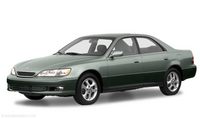New Car/Review
Lexus ES300 (2001)
SEE ALSO: Lexus Rover Buyer's Guide
By Matt/Bob Hagin
SPECIFICATIONS
Manufacturer's Suggested Retail Price $ 31,505
Price As Tested $ 35,608
Engine Type DOHC 24-valve 3.0 Liter V6 w/SMFI*
Engine Size 183 cid/2995 cc
Horsepower 210 @ 5800 RPM
Torque (lb-ft) 220 @ 4400 RPM
Wheelbase/Width/Length 105.1"/70.5"/190.2"
Transmission Four-speed automatic
Curb Weight 3558 pounds
Fuel Capacity 18.5 gallons
Tires (F/R) 205/65R15 v-rated
Brakes (F/R) Disc (ABS)/disc (ABS)
Drive Train Front-engine/front-wheel-drive
Vehicle Type Five-passenger/four-door
Domestic Content 15 percent
Coefficient of Drag (Cd.) 0.29
PERFORMANCE
EPA Economy, miles per gallon
city/highway/average 19/26/22
0-60 MPH 8.5 seconds
1/4 (E.T.) 16.0 seconds @ 88.0 mph
Top-speed 140 mph
* Sequential multi-port fuel injection
(Matt Hagin says Lexus hasn't been around as long as most other luxury brands. Bob Hagin says that as always, youth will be served.)
MATT - Lexus as a brand has certainly muscled its way into the luxury car market. The first of the genre didn't even get into the game until 1990 and in its first year it started with the ancestor of the car we're trying out this week. That first car was the ES 250 and it carried a V6 and all the luxury accouterments that could be packed inside. It wasn't a high-performance vehicle, but than as now, it concentrated on being elegant and refined rather than flashy and fast. Its sales numbers back this up. In this field, the Lexus ES 300 is a sort of heavy-hitter that wears soft leather gloves.
BOB - It's a good formula for us "mature" Americans, Matt, and I've been told that the median age of Lexus ES 300 buyers last year was 59. This doesn't sound all that old to me, but it indicates that lots of us who place a lot of importance in high quality, reliability, and subdued design are passing on traditional domestic cars to fulfill their need for a new set of wheels. Mechanically, the ES 300 has some pretty impressive parts. The 3.0-liter V6 is all-aluminum and that includes even the oil pan. There's two cams on each head that operate four valves per cylinder. The intake valve timing is continuously operated by a variable timing device that not only gives it 210 horses, but delivers 80-percent of its torque at only 1600 revs. If it had a stick-shift, the ES 300 would have great pulling power even at near-idle speed.
MATT - But a car like the ES 300 wasn't designed for buyers with a penchant for that kind of performance driving. Its four-speed automatic is extremely smooth, with seamless shifting points and no fancy stuff. You can't shift it like a stick-shift and you can't go into a "power mode." But the transmission is computer-controlled to work in conjunction with the anti-lock braking system and a traction control device that greatly reduces the likelihood of getting into trouble when the streets get icy or covered with snow. The system will even increase the pressure of the brake pedal if the computer senses that there's a panic situation happening, but the driver isn't hitting the pedal hard enough. And for those few ES 300 buyers who want to have more control at speed when the pavement gets as rough as a washboard, they can get an adaptive ride control system that automatically "tightens" the shock absorbers on the individual MacPherson struts at each corner. It's an optional extra but $600-plus on a car like this probably doesn't mean much to the buyer.
BOB - You're right, especially since that option is so noticeable on the road. That road smoothness is reflected inside, where soft leather and polished wood are everywhere, and with its multi-adjustable front seats and power lumbar support, it's hard not to find a comfortable seating position for anyone - tall or short. It's not quite the same in the back seat, Matt, and at six-foot-four, your brother Bren wouldn't be able to wear headgear much taller than his beloved Oakland Oaks baseball hat. The head room back there is a couple of inches lower than it is in front if the car is equipped with a moon roof.
MATT - I think you'd have a tough time finding a new ES 300 without a moon roof, since the main attraction of the car is its creature comforts. The Lexus press kit says that it can carry five Pullman trunks in back and still have room for a small fold-up motorcycle. There's a pass-through in the back seats to carry skis and such in case its owners are still spry enough to challenge the slopes. The standard tires are 15-inch V-rated mounted on aluminum wheels, but our tester rode on 16-inchers with a slightly more tenacious tread pattern. The spare is full-sized but surprisingly, its a steel unit and before I put it on, I'd want to make sure that the lug nuts are compatible.
BOB - The only fault I found with the ES 300 is the location of the parking brake handle. I kept hitting my leg on it.
MATT - Dad, I think you need more limbering up exercises.



